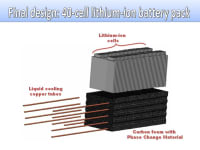In North America transportation accounts for 23% of the greenhouse gas emissions produced. To determine the amount of greenhouse gases produced, and to have a basis for comparison, a measurement known as “global warming potention” is used. This measure represents the amount of heat trapped by a greenhouse gas compared to carbon dioxide over a specific time interval. Using this measure, it becomes easy to compare an electric vehicle to an internal combustion (IC) vehicle; IC vehicles generally have a global warming potential three times greater than electric vehicles (EVs). At the heart of an electric vehicle lies the battery, which is the most expensive component of the vehicle (approximately 1/3). However they are also the leading cause of failure for electric vehicles. Lithium-ion cells are the future when it comes to electric vehicles due to their large capacities and relatively high efficiency.
A key component in maintaining the lifespan of a lithium-ion battery is to provide adequate operating and storing temperatures. Extreme weather variations make thermal management of electric vehicle batteries of prime importance. Unlike more common active methods such as liquid pumps or fans, phase change materials (PCMs) are a completely passive method since no energy is required. In pure electric vehicle applications PCMs will have a huge impact because thermal management can be done on the battery without the need to draw extra power. In addition, when drawing power from the battery to trigger the active methods, the mileage of the vehicle shortens. Phase change materials make use of their high latent heat of fusion to store and release large amounts of thermal energy.
In order to use the phase change material it is essential to contain the material to reduce the risk of leakage. PCMs also have fairly low thermal conductivity; therefore it must be embedded in something that can increase the rate at which heat is absorbed from the cell. Carbon foam is an ideal candidate for this application. Carbon foam consists of highly porous elemental graphite produced by heat treating carbon to very high temperatures. The resulting material can then be glued and machined normally. To understand some of the physical properties of this new material, it is important to understand the atomic structure of graphite. Graphite consists of layers of carbon atoms held together by strong covalent bonds. Atoms are arranged in a hexagonal pattern within each plane. These layers are 'stacked' on top of each other and held together by weaker Van-der-Waals forces. This difference between the atomic bond structure leads to different in-plane and out-of-plane mechanical, thermal and electrical properties. Therefore, it is common to define physical properties of graphite in terms of in-plane and out-of-plane directions. These directions can be advantageous, for example if liquid tubes were used to cool down the battery then the direction perpendicular to the walls of the tubes would need to have the highest conductivity. By orienting the carbon foam prior to machining, the desired conductivity in the required plane can be achieved.
Like this entry?
-
About the Entrant
- Name:Guillermo Maura
- Type of entry:teamTeam members:Guillermo Maura
Kevin Cheung
Sorabh Sharma
Mohammad Ruhomaun - Software used for this entry:SolidWorks
- Patent status:none








